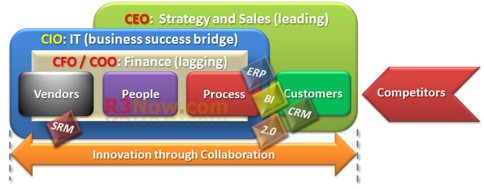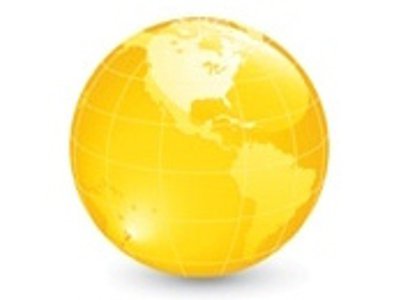This article is the last of a four-part series, which covered the entire breadth of the business to technology landscape of the future: IT organizational alignment, business alignment, and future technology alignment for success in tomorrow’s marketplace.
This final post takes a look at the emerging technology landscape and what the future holds.
What Does the Future Technology to Business Alignment Hold – Future ERP, SAP, and IT Value
A number of changes on the horizon will produce a number of winners and losers in the technology marketplace. Those software companies, system integrators, and consultants who only deliver narrowly tailored solutions to address operational concerns will find a shrinking landscape of customers to sell to, and the competition for the market space will drive prices down to commodity status. Together with this, the CIO, IT Director, or IT Decision Maker who focuses on the operational side or lagging indicators will continue to face greater cost containment requirements, no matter how well the business or economy performs. As the CFO and COO continue demanding more for less from the IT department to cover the cost side of the lagging indicator equation, the senior-level IT decision makers will find their career prospects more limited.
To propel an IT career forward in the years ahead, you will need to demonstrate business value within the overall organization. The CIO will need to carry the torch for bridging the business gap between the business lagging and leading indicators of business health. The important focus both now and in the coming years is on the demand side of the business equation. That demand side is a focus on customer acquisition, customer retention, sales conversions, upselling, cross-selling, and customer-centered innovation.
A New Wave Technology Model for IT Decision Maker Success
This is a technology alignment model that shows one possible method for CIO, IT Director, or other IT decision maker to achieve success in the demands to advance the business. Keep in mind, this is not an organizational model. Rather, it is a technology alignment model or a business-to-technology map.
This model represents the role of the CIO as the bridge between the lagging side of the business (finance, people, process) and the leading side of the business (strategy and sales). Although the CIO position appears above the CFO and COO organizationally, the positions are generally more equally aligned, or in many organizations, the CIO may answer to the CFO. The correct CIO role is one of technology integration between the lagging and leading sides of the business. The CIO role with the use of technology is the glue between the two sides. The CFO (who has responsibility for the CIO and technology spend) should encourage the CIO to act as a bridge between the CEO and CFO to ensure company health and promote business needs. As is often the case, success here will cause the company ship to rise in the marketplace.
CIO Alignment and Key Responsibilities of the Future Business-Aligned Technology Organization
The unfortunate reality is the CIO alignment in most modern organizations is almost exclusively housed in the lagging indicator category (see Part 2 and Part 3 of this series listed at the end). The zealous focus on only lagging indicators, with its heavy reliance on cost cutting (through automation, performance improvement, etc.) leads to cost cutting in the IT department itself.
After things are working and automated, the IT department is pressed into maintenance mode because the business does not see the revenue generation prospects of technology. They fail to see the possibilities of promoting customer retention, customer acquisition, innovation, and marketplace analytics.
The technology map of the future will focus aggressively on the customer integration into the business process. Collaboration activities will occur across the entire value chain, on both the lagging and leading indicator side of the business. Future collaborative integration will produce new market intelligence, product or service innovation, early defect detection and correction, and other business possibilities to retain and acquire new customers.
The future of the successful technology application will depend heavily on the ability to drive innovation and process improvement around customer retention, acquisition, and product or service innovation.
Part 1: What is the Proper Relationship for the CIO, CEO, and CFO?
In the first part of this series, we looked at the changing business landscape and what it means to the CIO, IT Director, IT Manager, and other key technology decision makers. From a high level, the current global business competition, as well as economic issues, are directly affecting the C-level executive requirements and the CIO–CFO–CEO dynamic. This article reviews how and where the CIO role is under tremendous pressure, and how to change the current dynamic by more appropriately partnering with the CFO and the CEO. This partnership is a critical business bridge between lagging business indicators of business health on the CFO–COO side of the business house, and the leading indicators of sales and product or service pipelines on the CEO side of the business house.
Part 2: CIO, CFO, and CEO Alignment – Why ROI is Lacking from Today’s System Landscape
The second part is an overview of the current system landscape and its focus on business processes and the customer. This piece also looks at the future business landscape and how the technology focus and direction will be permanently changed, no matter what happens with the economy and global competition. Because the technology marketplace (business consumer) is becoming more sophisticated and more attuned to business/technology alignment, the IT dynamic is going through a structural change. The whole technology sector is slowly moving away from the operational excellence value proposition to the customer focus and innovation areas of the business. Few of the consulting companies and application vendors see this change and are doing little to address it. This is the area of technology market winners and losers of the next twenty years.
Part 3: Changing the Direction of SAP, ERP, and IT Applications to Focus on the Customer and Innovation
The third part in the series looks at current technology landscapes and how they are aligned. In addition, the article looks at future technology landscapes. A brief review of the supply and demand side of business shows that unless you have lots of customers (demand) to fill a bigger and bigger pipeline (supply), then your business model collapses. While it is hidden during good economic climates, any disruption in those economic conditions that fails to fill the capacity pipeline points out the glaring insufficiency of the operational focus to technology. During any economic disruption, or any reduction in demand from customers for your products or services, the current technology model falls apart.
Part 4: Future Technology Landscape Alignment for the CIO, IT Director, or Key IT Decision Maker
The final part of the series looks at the emerging technology landscape and what the future holds. It lays out an emerging technology landscape model, which has some realignment and components already in use by some of the world’s most successful companies. A new alignment of technology with the customer-facing processes, as well as the use of social or collaboration tools across the enterprise, is explored. The driver for the future change will be because the business does not see the revenue generation prospects of technology. They fail to see the possibilities of promoting customer retention, customer acquisition, innovation, and marketplace analytics. The new technology model looks to change that dynamic.







